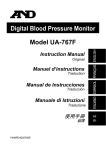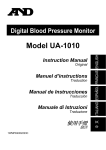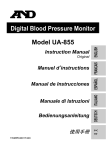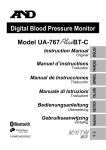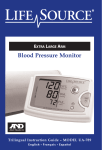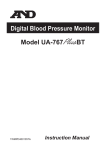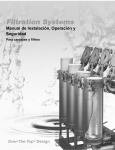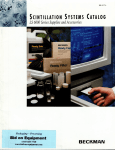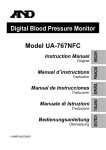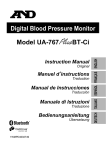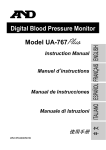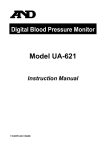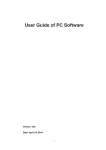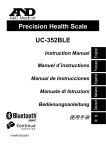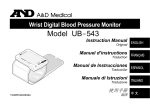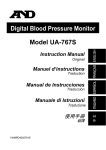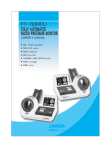Download Digital Blood Pressure Monitor
Transcript
Digital Blood Pressure Monitor Model UA -767F/ UA-767FAC Instruction Maual Original Manual de Instrucciones Traducción 1WMPD4002977 Contents Contents ........................................................................................... 1 Welcome Message ........................................................................... 2 Preliminary Remarks ........................................................................ 2 Precautions ....................................................................................... 2 Parts Identification ............................................................................ 4 Symbols ............................................................................................ 5 Operation Mode ................................................................................ 7 1. Normal Measurement.............................................................. 7 2. Recalling the Data ................................................................... 7 3. Changing user for memory display ......................................... 7 4. Deleting Data Stored in Memory ............................................. 8 5. Measurement with the Desired Systolic Pressure ................... 8 6. User Selection ......................................................................... 8 Using the Monitor.............................................................................. 9 Installing / Changing the Batteries .............................................. 9 Connecting the Air Hose ............................................................. 9 Connecting the AC Adapter ........................................................ 9 Adjusting the Built-in Clock ....................................................... 10 Selecting the Correct Cuff Size ................................................. 11 Applying the Arm Cuff ............................................................... 11 How to take Accurate Measurements ......................................... 12 Measurement ............................................................................ 13 After Measurement .................................................................... 13 Measurement s.................................................................................14 Normal Measurement................................................................ 14 Measurement with the Desired Systolic Pressure ..................... 15 Notes for Accurate Measurement .............................................. 15 Recalling the Memory Data ............................................................ 16 What is an Irregular Heartbeat ........................................................ 18 IHB .............................................................................................. 18 Pressure Bar Indicator .................................................................... 19 Pressure Rating Indicator ............................................................... 19 About Blood Pressure ..................................................................... 20 What is Blood Pressure? ........................................................... 20 What is Hypertension and How is it Controlled? ....................... 20 Why Measure Blood Pressure at Home? .................................. 20 Blood Pressure Classification ................................................... 20 Blood Pressure Variations ......................................................... 21 Troubleshooting .............................................................................. 22 Maintenance ................................................................................... 22 Technical Data ................................................................................ 23 Warranty ......................................................................................... 25 English 1 Welcome Message Congratulations on purchasing a state-of-the-art A&D blood pressure monitor, one of the most advanced monitors available today. Designed for ease of use and accuracy, this monitor will facilitate your daily blood pressure regimen. We recommend that you read through this manual carefully before using the device for the first time. Preliminary Remarks The device is designed for use on adults only, not newborns or infants. Environment for use. The device is for use in the home healthcare environment. This device is designed to measure blood pressure and pulse rate of people for diagnosis. Precautions Precision components are used in the construction of this device. Extremes in temperature, humidity, direct sunlight, shock or dust should be avoided. Clean the device and cuff with a dry, soft cloth or a cloth dampened with water and a neutral detergent. Never use alcohol, benzene, thinner or other harsh chemicals to clean the device or cuff. Avoid tightly folding the cuff or storing the hose tightly twisted for long periods of time as such treatment may shorten the life of the components. The device and cuff are not water resistant. Prevent rain, sweat and water from soiling the device and cuff. Measurements may be distorted if the device is used close to televisions, microwave ovens, cellular telephones, X-ray or other devices with strong electrical fields. When reusing the device, confirm that the device is clean. Used equipment, parts and batteries are not treated as ordinary household waste, and must be disposed of according to the applicable local regulations. English 2 Do not modify the device. It may cause accidents or damage to the device. To measure blood pressure, the arm must be squeezed by the cuff hard enough to temporarily stop blood flow through the artery. This may cause pain, numbness or a temporary red mark to the arm. This condition will appear especially when measurement is repeated successively. Any pain, numbness, or red marks will disappear with time. People who have a severe circulatory deficit in the arm must consult a doctor before using the device to avoid medical problems. Do not self-diagnose the measurement results. Always consult your doctor for evaluation of the results and treatment. Do not apply cuff on an arm with other medical equipment attached. Neither equipment may function properly. Do not apply the cuff on an arm with an unhealed wound. Do not apply the cuff on an arm receiving an intravenous drip or blood transfusion. It may cause injury or accidents. Do not use the device where flammable gases such as anesthetic gases are present. It may cause an explosion. Do not use the device in highly concentrated oxygen environments, such as a high-pressure oxygen chamber or an oxygen tent. It may cause a fire or explosion. Do not excessively bend or squeeze the air hose. When the AC adapter is used, make sure that the AC adapter can be readily removed from the electrical outlet when necessary. Do not twist the cuff hose. This may cause injury due to continuous cuff pressure. Measuring blood pressure too frequently may cause harm due to blood flow interference. Check that operation of the device does not result in prolonged impairment of blood circulation, when using the device repeatedly. If you have had a mastectomy, please consult a doctor before using the device. Take care to avoid accidental strangulation with babies or infants by the hose. Please note the accidental ingestion of small parts. English 3 Parts Identification Button Button SET Button AC adapter plug DC Jack Air Connector Plug START Button Air Socket Display Air Hose Proper Fit Range Artery Position Mark Index Mark Arm Cuff Battery Compartment Battery Cover 1.5V Batteries (R6P, LR6 or AA) Display MEMORY Average I.H.B. Symbol (Irregular heartbeat symbol) Systolic Pressure %IHB Cuff Fit Error Symbol Diastolic Pressure Movement Error Symbol Heart Mark JNC7 Classification Indicator and Pressure Bar Indicator Pulse Rate Date & Clock Display Battery Indicator AM / PM Mark User English 4 Symbols Symbols that are printed on the device case Symbols Function / Meaning Standby and Turn the device on. SYS. Systolic blood pressure in mmHg DIA. Diastolic blood pressure in mmHg PUL. Pulse per minute Battery installation guide SN Direct current Type BF: Device, cuff and tubing are designed to provide special protection against electrical shocks. Serial number Refer to instruction manual/booklet Polarity of DC jack Symbols that appear on the display Symbols Function / Meaning Appears while measurement is in progress. It blinks when the pulse is detected. Irregular Heartbeat symbol (I.H.B.) Appears when an irregular heartbeat is detected. It may light when a very slight vibration like shivering or shaking is detected. Appears when a body or arm movement is detected. English 5 Recommended Action Measurement is in progress. Remain as still as possible. The reading may yield an incorrect value. Take another measurement. Remain still during measurement. Symbols Symbols Function / Meaning Appears during measurement when the cuff is attached loosely Detected rate of IHB in memory Recommended Action The reading may yield an incorrect value. Apply the cuff correctly and take another measurement. User Previous measurements stored in memory. Average data Full Battery Low Battery The battery power indicator during measurement. The battery is low when it blinks. Unstable blood pressure due to movement during measurement. The systolic and diastolic values are within 10 mmHg of each other. The pressure value did not increase during the inflation. The cuff is not applied correctly. PUL. DISPLAY ERROR Apply the cuff correctly and take another measurement. The pulse was not detected correctly. Blood pressure monitor internal error SYS. DIA. PUL./min. AM PM Replace all batteries with new ones when the mark blinks Take another measurement. Remain very still during measurement. Systolic blood pressure in mmHg Diastolic blood pressure in mmHg Pulse per minute Data taken between 4:00 and 9:59 Data taken between 18:00 and 1:59 English 6 Remove the batteries and press the START button, and then install the batteries again. If the error still appears contact the manufacturer. Operation Mode 1. Normal Measurement Press the START button. Blood pressure is measured and the data is stored in memory. This device can store the last 60 measurements for each of the four user in memory. 2. Recalling the Data Press the or button to recall the data in memory. The average of all measurements is displayed, as indicated in the figure at the right. Then, each time the button is pressed, the memory data is displayed as follows. Most recent data (No.n, in the example, No.35) Last data (No.1) For details on recalling the data, refer to “Recalling the Memory Data”. 3. Changing user for memory display Press the SET button while a memory is displayed. The user is changed, and the average of measurement values for that user is displayed. English 7 4. Deleting Data Stored in Memory In standby, press both the and buttons. The mark, battery indicator and user mark will appear. When you would like to delete the memory data of the currently displayed user, press and hold both the and buttons until the illuminated mark starts blinking. 5. Measurement with the Desired Systolic Pressure Refer to page 15 for measurement with the desired systolic pressure. 6. User Selection Press the SET button before measuring blood pressure to select a user from 1 to 4. In standby, press the SET button. Each time the SET button is pressed, the user changes. Press the START button to set to the currently displayed user. English 8 Using the Monitor Installing / Changing the Batteries 1. Remove the battery cover. 2. Remove the used batteries and insert new batteries into the battery compartment as shown, taking care that the polarities (+ and -) are correct. Use only R6P, LR6 or AA batteries. 3. Attach the battery cover. Step 1 Step 3 Step 1 Step 2 CAUTION Insert the batteries as shown in the battery compartment. If installed incorrectly, the device will not work. When (LOW BATTERY mark) blinks on the display, replace all batteries with new ones. Do not mix old and new batteries. It may shorten the battery life, or cause the device to malfunction. Replace the batteries two seconds or more after the device turns off. If (LOW BATTERY mark) appears even after the batteries are replaced, make a blood pressure measurement. The device may then recognize the new batteries. (LOW BATTERY mark) does not appear when the batteries are drained. The battery life varies with the ambient temperature and may be shorter at low temperatures. Use the specified batteries only. Remove the batteries if the device is not to be used for a long time. The batteries may leak and cause a malfunction. Four new AA alkaline batteries will last Air socket approximately one year when used twice r socket for measurement each day. Connecting the Air Hose Insert the air connector plug into the air socket firmly. Air connector plug Connecting the AC Adapter Insert the AC adapter plug into the DC jack. Next, connect the AC adapter to an electrical outlet. Use the specified AC adapter. NOTE: When you unplug the AC adapter from the electrical outlet, please grasp and pull the AC adapter body. When you remove the AC adapter plug from the blood pressure monitor, please grasp and pull the adapter plug. Doing otherwise may cause a fire, electric shock or malfunction. English 9 DC jack AC adapter plug Using the Monitor Adjusting the Built-in Clock Press and hold Adjust the clock prior to use. 1. Press and hold the SET button until the year starts blinking. 2. Select the year using the or button. Press the SET button to set the current year and move to month/day selection. The date can be set anywhere between the years 2013 and 2059. or 3. Select the month using the button. Press the SET button to set the current month and move to day selection. 4. Select the day using the or button. Press the SET button to set the current day and move to hour/minute selection. or button. 5. Select the hour using the Press the SET button to set the current hour and move to minute selection. 6. Select the minute using the or button. Press the START or SET button to turn the device off. Holding down the or the value continuously. button will change or Year or Month or Day or Hour or Minute START or Note: After three minutes of non-operation, the device will turn off automatically. When the clock has not been set, the clock display indicates dashes as shown to the right. English 10 Turn off Using the Monitor Selecting the Correct Cuff Size Using the correct cuff size is important for an accurate reading. If the cuff is not the proper size, the reading may yield an incorrect blood pressure value. The arm size is printed on each cuff. The index and proper fit range, on the cuff, tell you if you are applying the correct cuff. (Refer to "Symbols that are printed on the cuff" on the next page) points outside of the range, contact your local dealer to purchase a If the index replacement cuff. The arm cuff is a consumable. If it becomes worn, purchase a new one. Catalog Number Cuff Size Arm Size UA-290 Medium cuff 9.0" - 14.6" (23 - 37 cm) UA-291 Large cuff 12.2" - 17.7" (31 - 45 cm) UA-420 AccuFit™ Plus Cuff 8.6" - 16.5" (22 - 42 cm) Arm size: The circumference at the biceps. Note: Model UA-767F is not designed for using a small cuff. Do not roll up shirtsleeve tightly. Applying the Arm Cuff 1. Wrap the cuff around the upper arm, about 1-2 cm above the inside of the elbow, as shown. Place the cuff directly against the skin, as clothing may cause a faint pulse, and result in a measurement error. Cuff Air Hose Artery position mark 2. Constriction of the upper arm, caused by tightly rolling up a shirtsleeve, may prevent accurate readings. 3. Confirm that the index within the proper fit range. 1-2 cm Secure the fabric fastener firmly. points Index English 11 and proper fit range Using the Monitor Symbols that are printed on the cuff Symbols Function / Meaning Artery Position Mark REF M M Index Catalog number Proper fit range for the medium cuff. It's printed on the cuff. Range to use the large cuff. Over range printed on the medium cuff and AccuFit™ Plus cuff. Proper fit range for the AccuFit™ Plus cuff It's printed on AccuFit™ Plus cuff. Proper fit range for the large cuff. It's printed on the large cuff. Under range printed on the medium cuff and AccuFit™ Plus cuff. Range to use the medium cuff. It's printed on the large cuff. Recommended Action Set the mark on the artery of the upper arm or in line with the ring finger on the inside of the arm. Use the large cuff instead of the medium cuff. Use the medium cuff instead of the large cuff. Lot number Large cuff M Proper fit range L AccuFit™ Plus cuff. S Medium cuff S W L M L How to Take Accurate Measurements For the most accurate blood pressure measurement: • Sit comfortably on a chair. Rest your arm on the table. Do not cross your legs. Keep your feet on the floor and straighten your back. • Relax for several minutes before measurement. • Place the center of the cuff at the same level as your heart. • Remain still and keep quiet during measurement. • Do not measure immediately after physical exercise or a bath. Rest for twenty or thirty minutes before taking the measurement. English 12 • Try to measure your blood pressure at the same time every day. Measurement During measurement, it is normal for the cuff to feel very tight. (Do not be alarmed). After Measurement After measurement, press the START button to turn the device off. After one minute of non-operation, the device will turn off automatically. Remove the cuff and record your data. English 13 Measurements Before measurement, read “Notes for Accurate Measurement” on the next page. Normal Measurement 1. Press the SET button to select a user from 1 to 4. At heart level Press 2. 3. 4. 5. 6. 7. Place the cuff on the arm (preferably the left arm). Sit quietly during measurement. All of the display START segments displayed Press the START button. All of the display segments are displayed. Zero (0) is displayed blinking briefly. The display changes, as indicated in the figure at the right, as the measurement Zero display begins. The cuff starts to inflate. It is normal Starts inflation for the cuff to feel very tight. A pressure bar indicator is displayed, on the left edge of the display, during the inflation. Note: If you wish to stop inflation at any time, press the START button again. Pressurizing When inflation is complete, deflation starts automatically and (heart mark) blinks, indicating that the measurement is in progress. Once the pulse is detected, the mark blinks with each pulse beat. Note: If an appropriate pressure is not obtained, the device starts to inflate again automatically. To avoid re-inflation, see “Measurement with the Desired Systolic Pressure” on the next page. Measurement in progress When the measurement is complete, the systolic and diastolic pressure readings and pulse rate are displayed. Systolic pressure The cuff exhausts the remaining air and Diastolic pressure deflates completely. WHO classification When not recording the measurement data, press the or button. Pulse rate Press the START button to turn the device off. Exhausts remaining After one minute of non-operation, air automatically the device will turn off automatically. English 14 Measurements Measurement with the Desired Systolic Pressure Model UA-767F is designed to detect the pulse and to inflate the cuff to a systolic pressure level automatically. Use this method when re-inflation occurs repeatedly or when the results are not displayed even if the pressure decreases to 20 mmHg or less. 1. Place the cuff on the arm at heart level (preferably the left arm). At heart level 2. Press and hold the START button until a number about 30 to 40 mmHg higher than your expected systolic pressure appears. Press and hold the button 3. When the desired number is reached, release the START button to start measurement. Continue to measure your blood pressure as described on the previous page. START Release the button at the desired systolic pressure Refer to the previous page for measurement Notes for Accurate Measurement Sit down in a comfortable position. Place your arm on a table with your palm facing upward and the cuff at the same level as your heart. Relax for about five to ten minutes before taking a measurement. If you are excited or depressed by emotional stress, the measurement will reflect this stress as a higher (or lower) than normal blood pressure reading and the pulse reading will usually be faster than normal. An individual's blood pressure varies constantly, depending on what you are doing and what you have eaten. What you drink can have a very strong and rapid effect on your blood pressure. This device bases its measurements on the heartbeat. If you have a very weak or irregular heartbeat, the device may have difficulty determining your blood pressure. Should the device detect a condition that is abnormal, it will stop the measurement and display an error symbol. Refer to page 6 for the description of symbols. This blood pressure monitor is intended for use by adults only. Consult with your physician before using this device on a child. A child should not use this device unattended. English 15 Recalling the Memory Data Note: This device stores the last 60 measurements for each of the four user in memory. 1. Press the or button. The average of all measurements and the number of data are displayed. (If no data, “0” is displayed. Press the , or START button to turn the device off.) Average systolic Average diastolic Average of all the data 2. Each time the button (or the button to display the data in the reverse order) is pressed, the memory data is displayed as follows. Average pulse Systolic Diastolic Most recent data (No.n, in the example, No.35) Three seconds after the data number display, the measurement data is displayed. Pulse Most recent data Last data (No.1) Three seconds after the data number display, the measurement data is displayed. 3. After the last data is displayed, press the button to return the average display of all measurements. Systolic Diastolic Pulse Last data (Oldest) 4. Press the SET button to display the memory display after changing the user number. English 16 5. Press the START button to turn the device off. After one minute of non-operation, the device will turn off automatically. User 1 User 2 User 3 User 4 English 17 What is an Irregular Heartbeat The UA-767F blood pressure monitor provides a blood pressure and pulse rate measurement even when an irregular heartbeat occurs. An irregular heartbeat is defined as a heartbeat that varies by 25% from the average of all heartbeats during the blood pressure measurement. It is important that you are relaxed, remain still and do not talk during measurements. Note: We recommend contacting your physician if you see this indicator frequently. %IHB %IHB is displayed as frequency of IHB detected. IHB can detect not only noises such as physical movement but also an irregular heartbeat. Therefore, we recommend contacting your physician if %IHB level is high. Display of %IHB: %IHB is displayed when displaying average values. (Refer to “2. Recalling the Data” in “Operation Mode”) %IHB is not displayed when the memory number is six or less. Average value display Level 0 %IHB=0~24 Level 1 %IHB=25~49 Level 2 %IHB=50~74 Not displayed English 18 Level 3 %IHB=75~100 Pressure Bar Indicator The indicator monitors the progress of pressure during measurement. Pressurizing Releasing air Inflation in progress Measurement in progress Inflation complete Pressure Rating Indicator The Pressure Rating Indicator™ is a feature, which provides a snapshot of your blood pressure classification based on your measurements. This will let you quickly know what your blood pressure readings mean. Each segment of the bar indicator corresponds to the Seventh Report of the Joint National Committee (JNC7) on Prevention, Evaluation and Treatment of High Blood Pressure from the National Heart, Lung and Blood Institute May 2003. Stage 2 Hypertension Stage 1 Hypertension Prehypertension Normal Example Stage 2 Hypertension NOTE: Due to other risk factors (e.g. diabetes, obesity, smoking, etc.) in addition to your blood pressure measurement, the Pressure Rating Indicator is approximate. Please consult with your physician for interpretation and diagnosis of your blood pressure measurements. English 19 About Blood Pressure What is Blood Pressure? Blood pressure is the force exerted by blood against the walls of the arteries. Systolic pressure occurs when the heart contracts. Diastolic pressure occurs when the heart expands. Blood pressure is measured in millimeters of mercury (mmHg). One's natural blood pressure is represented by the fundamental pressure, which is measured first thing in the morning while one is still at rest and before eating. What is Hypertension and How is it Controlled? Hypertension, an abnormally high arterial blood pressure, if left unattended, can cause many health problems including stroke and heart attack. Hypertension can be controlled by altering lifestyle, avoiding stress, and with medication under a doctor’s supervision. To prevent hypertension or keep it under control: Do not smoke Exercise regularly Reduce salt and fat intake Have regular physical checkups Maintain proper weight Why Measure Blood Pressure at Home? It is now well known that, for many individuals, blood pressure readings taken in a doctor’s office or hospital setting might be elevated as a result of apprehension and anxiety. This response is commonly called “white coat hypertension.” In any case, self-measurement at home supplements your doctor’s readings and provides a more accurate, complete blood pressure history. In addition, clinical studies have shown that the detection and treatment of hypertension is improved when patients both consult their physicians and monitor their own blood pressure at home. Blood Pressure Classification The following standards for assessing high blood pressure (without regard to age or gender) have been established as a guideline. Please note that other risk factors (e.g. diabetes, obesity, smoking, etc.) need to be taken into consideration and may affect these figures. Consult with your physician for an accurate assessment. English 20 BP Classification Normal Systolic (mmHg) (mmHg) Less than 120 Diastolic and less than 80 Prehypertension 120-139 or 80-89 Stage 1 Hypertension 140-159 or 90-99 Stage 2 Hypertension 160 or 100 JNC7 Classification Table – for adults within the U.S BP Classification Systolic (mmHg) Dia SOURCE: The Seventh Report of the Joint National Committee on Prevention, Evaluation and Treatment of High Blood Pressure for adults. National Heart, Lung and Blood Institute - May 2003. Blood Pressure Variations An individual’s blood pressure varies greatly on a daily and seasonal basis. It may vary by 30 to 50 mmHg due to various conditions during the day. In hypertensive individuals, variations are even more pronounced. Normally, the blood pressure rises while at work or play and falls to its lowest levels during sleep. So, do not be overly concerned by the results of one measurement. Take measurements at the same time every day using the procedure described in this manual to get to know your normal blood pressure. Regular readings give a more comprehensive blood pressure history. Be sure to note the date and time when recording your blood pressure. Consult your doctor to interpret your blood pressure data. English 21 Troubleshooting Problem Possible Reason Batteries are drained. Nothing appears on the display, even Battery terminals are not when the power in the correct position. is turned on. The cuff does not inflate. Battery voltage is too low. (LOW BATTERY mark) blinks. If the batteries are drained completely, the mark does not appear. The cuff is not applied properly. You moved your arm or body during measurement. The device does not measure. The cuff position is not Readings are correct. too high or too low. Other The value is different from that measured at a clinic or doctor’s office. Recommended Action Replace all batteries with new ones. Reinstall the batteries with negative and positive terminals matching those indicated on the battery compartment. Replace all batteries with new ones. Apply the cuff correctly. Make sure you remain very still and quiet during measurement. Sit comfortably and still. Place your arm on a table with your palm facing upward and the cuff at the same level as your heart. If you have a very weak or irregular heat beat, the device may have difficulty in determining your blood pressure. Refer to “Why Measure Blood Pressure at Home?”. Remove the batteries. Place them back properly and take another measurement. Note: If the actions described above do not solve the problem, contact the dealer. Do not attempt to open or repair this product, as any attempt to do so will make your warranty invalid. Maintenance Do not open the device. It uses delicate electrical components and an intricate air unit that could be damaged. If you cannot fix the problem using the troubleshooting instructions, contact the authorized dealer in your area or our customer service department. English 22 Technical Data Type Measurement method Measurement range Measurement accuracy Power supply Number of measurements UA-767F/FAC Oscillometric measurement Pressure: 0 - 299 mmHg Systolic pressure: 60 - 279 mmHg Diastolic pressure: 40 - 200 mmHg Pulse: 40 - 180 beats / minute Pressure: ±3 mmHg Pulse: ±5% 4 x 1.5V batteries (R6P, LR6 or AA) or AC adapter (TB-233) UA-767F includes 4 batteries. UA-767FAC includes an AC adapter. Weight Approx. 700 times LR6 (alkaline batteries) Approx. 200 times R6P (manganese batteries) With pressure value 180 mmHg, room temperature 73.4 °F (23 °C.) Internally powered ME equipment (Supplied by batteries) / Class II (Supplied by adapter) Continuous operation mode According to ANSI / AAMI SP-10 1992 IEC 60601-1-2: 2007 Last 60 measurements for each of the four user +50°F to +104°F (10°C to 40°C) / 15 to 85 %RH / 800 to 1060 hPa -4°F to +140°F (-20°C to 60°C) / 10%RH to 95%RH Approx. 5.5" (140mm) [W] x 2.3" (60mm) [H] x 4.1" (105mm) [D] Approx. 9.0 oz. (255 g), excluding the batteries Applied part Cuff: Type BF Useful life Device: Cuff: 5 years (when used six times a day) 2 years (when used six times a day) Classification Clinical test EMC Memory Operating conditions Storage condition Dimensions English 23 Accessory AC adapter The adapter is to connect the device to a power source at home. Please contact your local A&D dealer for purchasing. ! ! TB-233 Input: 120V Output: 6V 500mA 139 C 2A Replacement cuffs sold separately Cuff Catalog Number Cuff Size Arm Size UA-290 Medium cuff 9.0" - 14.6" (23 - 37 cm) UA-291 Large cuff 12.2" - 17.7" (31 - 45 cm) UA-420 AccuFit™ Plus 8.6" - 16.5" (22 - 42 cm) Arm size: The circumference at the biceps. Note: Specifications are subject to change without prior notice. EMC table information is listed on our website: http://www.aandd.jp/products/manual/medical/emc_acadapter_en English 24 Warranty LIMITED FIVE YEAR WARRANTY A&D Medical Blood Pressure Monitor Only for Retail Purchasers within the US. [For retail purchasers outside the US, NO warranty is provided by A&D – please contact your local distributor or dealer.] A&D Medical (“A&D”) warrants to the first retail purchaser (“You”) that this blood pressure monitor (the “Product”) will be free from defects in material and workmanship for limited five year under normal use. If the Product contains a blood pressure cuff, the warranty period for such cuff is limited to two years from the date You purchased the Product. This Limited Warranty is personal to You and is not transferable. If a Product is defective, You can return the Product to the retailer You purchased it from (if within such retailer’s return time frame) or return it to A&D in accordance with the procedure set forth below. A&D’s warranty obligation is limited to the repair or replacement, at A&D’s option, of the defective Product that has been returned by You within the warranty period. Such repair or replacement will be at no charge to You. The repaired or replacement Product is warranted hereunder for the longer of the remainder of the original warranty period or 90 days from the date of shipment of the repaired or replacement Product. If you return the Product for warranty service to A&D, You must return the Product, freight and insurance prepaid, within the warranty period to the address set forth below, together with satisfactory proof of the date of Your purchase (such as a sales receipt or statement of online warranty registration). Also, please enclose a check for return shipping and insurance of the Product back to You. In the United States, to: A&D Medical Attn.: Warranty Department 1756 Automation Parkway San Jose, CA 95131 1-888-726-9966 Please contact in the US: A&D Medical, at the numbers set forth above for the appropriate shipping costs. English 25


























